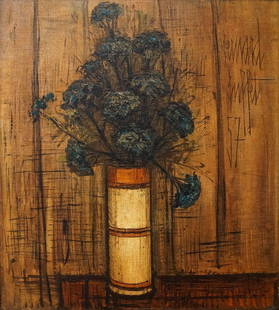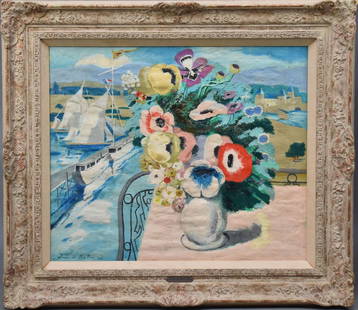
French school of ca. 1730. "The nymph Callisto seduced by Jupiter in the form of Diana". Oil on
Similar Sale History
Recommended Items








Item Details
Description
French school of ca. 1730.
"The nymph Callisto seduced by Jupiter in the form of Diana".
Oil on canvas. Relined.
Size: 82 x 83.5 cm; 106 x 106 cm (frame).
The gestation of the rococo painting takes place in France during the period of the Regency of Philip of Orleans (1715-23), having its stellar period during the reign of Louis XV (1723-74). The style represented the "discovery of freedom", the main idea of the society of the time. It was a hedonistic style of painting, centred on formal beauty and pleasant subjects, reflecting contemporary high society. In contrast to the thematic and formal rigour of the Baroque, Rococo represented colour and sensuality. One of the favourite themes par excellence during this period was love, which became a society game in which the libertine acted as a virtuoso. The game is broken down into four figures: choice, seduction, fall and rupture, all developed at a very fast pace. In the case of this painting, the scene depicted corresponds to the second moment, that of seduction, which was by far the favourite one for painters. The scene depicts the deception of the god Jupiter by the nymph Callisto, an episode narrated by Ovid in the Metamorphoses (Book II). Callisto, a nymph of great beauty and a member of Diana's retinue, was seduced by Jupiter, who took on Diana's features. Pregnant, the nymph tried to hide her condition from the goddess, who, a virgin herself, forced her companions to remain celibate. Jupiter turned her lover into a bear to spare her from punishment but, discovering the deception, Diana shot her with arrows. On her death, Callisto was taken to heaven by Jupiter, who placed her among the constellations and named her Ursa Major. Thus, the composition shows the goddess Diana, goddess of the hunt, with the fourth moon on her head and a quiver on her back. Next to her, Cupid (carrying the bow and arrows) rests on an eagle.
The elements indicated are those that help to identify the two figures. Diana, in ancient Roman mythology, was the virgin goddess of the hunt, associated with animals and wild lands (forests, jungles...) and, later, supplanting Luna as the goddess of the hunt (which is why her attributes include the crescent quarter). Callisto was sometimes described as a nymph, and classical mythology considered her to be the daughter of the Pelasgian king Lycaon, as well as part of the court of Artemis or Diana. Ovid ("The Metamorphoses") records one episode in particular that reflects the relationship between the two: it would show here the moment when the goddess discovers that her maiden has become pregnant by Zeus (Jupiter in Roman mythology), who had transformed himself into Diana to get closer to the nymph; or, perhaps, the very moment of the impersonation. This theme has been treated by masters such as Rubens, Dosso Dossi, Palma the Elder, Gaetano Gandolfi, Guglielmo della Porta, Titian (two versions), Boucher, Federico Cervelli, Nicolas René Jollain, etc.
"The nymph Callisto seduced by Jupiter in the form of Diana".
Oil on canvas. Relined.
Size: 82 x 83.5 cm; 106 x 106 cm (frame).
The gestation of the rococo painting takes place in France during the period of the Regency of Philip of Orleans (1715-23), having its stellar period during the reign of Louis XV (1723-74). The style represented the "discovery of freedom", the main idea of the society of the time. It was a hedonistic style of painting, centred on formal beauty and pleasant subjects, reflecting contemporary high society. In contrast to the thematic and formal rigour of the Baroque, Rococo represented colour and sensuality. One of the favourite themes par excellence during this period was love, which became a society game in which the libertine acted as a virtuoso. The game is broken down into four figures: choice, seduction, fall and rupture, all developed at a very fast pace. In the case of this painting, the scene depicted corresponds to the second moment, that of seduction, which was by far the favourite one for painters. The scene depicts the deception of the god Jupiter by the nymph Callisto, an episode narrated by Ovid in the Metamorphoses (Book II). Callisto, a nymph of great beauty and a member of Diana's retinue, was seduced by Jupiter, who took on Diana's features. Pregnant, the nymph tried to hide her condition from the goddess, who, a virgin herself, forced her companions to remain celibate. Jupiter turned her lover into a bear to spare her from punishment but, discovering the deception, Diana shot her with arrows. On her death, Callisto was taken to heaven by Jupiter, who placed her among the constellations and named her Ursa Major. Thus, the composition shows the goddess Diana, goddess of the hunt, with the fourth moon on her head and a quiver on her back. Next to her, Cupid (carrying the bow and arrows) rests on an eagle.
The elements indicated are those that help to identify the two figures. Diana, in ancient Roman mythology, was the virgin goddess of the hunt, associated with animals and wild lands (forests, jungles...) and, later, supplanting Luna as the goddess of the hunt (which is why her attributes include the crescent quarter). Callisto was sometimes described as a nymph, and classical mythology considered her to be the daughter of the Pelasgian king Lycaon, as well as part of the court of Artemis or Diana. Ovid ("The Metamorphoses") records one episode in particular that reflects the relationship between the two: it would show here the moment when the goddess discovers that her maiden has become pregnant by Zeus (Jupiter in Roman mythology), who had transformed himself into Diana to get closer to the nymph; or, perhaps, the very moment of the impersonation. This theme has been treated by masters such as Rubens, Dosso Dossi, Palma the Elder, Gaetano Gandolfi, Guglielmo della Porta, Titian (two versions), Boucher, Federico Cervelli, Nicolas René Jollain, etc.
Buyer's Premium
- 23%
French school of ca. 1730. "The nymph Callisto seduced by Jupiter in the form of Diana". Oil on
Estimate €12,000 - €15,000
8 bidders are watching this item.
Shipping & Pickup Options
Item located in Barcelona, -, esOffers In-House Shipping
Payment

Related Searches
TOP





















































